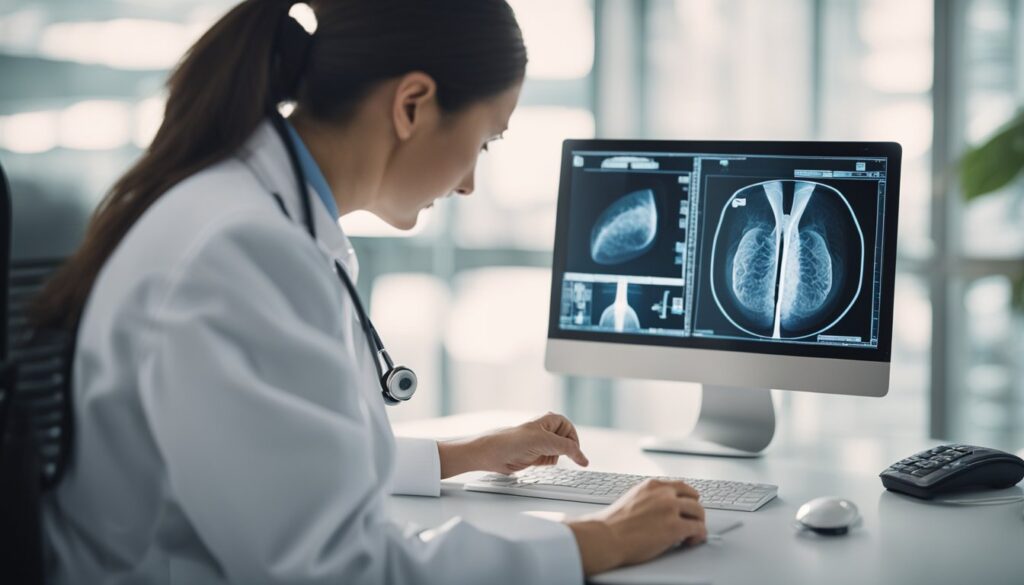Fibrocystic breast disease is characterized by lumpy, often tender breasts, resulting from hormone-related changes in breast tissue. Although commonly referred to as a disease, it is not a disease but a benign condition that many women experience at some point in their lives. Your breasts may feel thickened, tender, or swollen, with these symptoms fluctuating in tandem with your menstrual cycle.

Your healthcare provider may determine that you have fibrocystic breasts based on symptoms, a clinical breast exam, or imaging tests such as a mammogram or an ultrasound. It’s important to note that having fibrocystic breasts does not increase your risk of breast cancer.
Treatment for fibrocystic breasts aims to alleviate discomfort. Simple measures like adjusting your diet, wearing a supportive bra, or using over-the-counter pain relievers can be effective. In more bothersome cases, your doctor might suggest other treatments or medications. Managing pain and understanding the condition are key components of living comfortably with fibrocystic breast changes.
Understanding Fibrocystic Breast Disease

Fibrocystic breast disease, often referred to as fibrocystic breast changes, is a benign condition where you may notice your breasts feeling lumpy or rope-like in texture. This is a common phenomenon and isn’t necessarily a cause for concern.
Symptoms: The changes in your breast tissue are most often characterized by pain, tenderness, and the presence of dense breast tissue. You might find lumps in your breasts, which could feel like small balls or peas under the skin.
Causes: These breast changes are largely linked to your menstrual cycle and the fluctuating levels of hormones—particularly estrogen and progesterone. These hormones affect the milk ducts and lobules, which are the milk-producing glands. The hormonal shifts can cause fibrosis (thickening of the connective tissue) and the formation of cysts, fluid-filled sacs.
- Fibrosis: Fibrous tissue can feel firm or rubbery.
- Cysts: These can range in size, and some may be large enough to be felt through the skin.
Your breasts may feel more lumpy or tender before your menstrual period and then return to a more normal state post-menstrually. If your breast tissue feels unusually dense, this can be a normal part of the fibrocystic changes.
Understanding that these changes in the breasts can mirror normal breast pain or discomfort associated with your menstrual cycle is essential. However, cystic changes can be unsettling if you’re not familiar with the condition. Regular clinical breast exams can help confirm the benign nature of these changes.
Regular monitoring of your breasts is crucial, and you should always consult healthcare professionals when you notice any new or persisting lumps or changes. The Mayo Clinic provides guidance on diagnosis and treatment, while information on the pathophysiology and management is available through resources like StatPearls.
Diagnosis and Treatment

When addressing fibrocystic breast disease, it’s crucial to engage in appropriate diagnostic techniques to distinguish it from other conditions and implement effective treatment options. Managing symptoms through home management and lifestyle changes is also beneficial, as is understanding when medical interventions are necessary. Lastly, it is important to maintain monitoring and long-term management to ensure the best possible quality of life.
Diagnostic Techniques
Your healthcare provider may start with a clinical breast exam to feel for lumps or areas of thickening. If further investigation is warranted, a mammogram can be conducted to capture detailed images of the breast tissue. For more clarity, particularly in women under 30, a breast ultrasound can be used to differentiate solid from fluid-filled cysts. If a suspicious area is found, a biopsy, such as a fine-needle aspiration, may be performed where a needle is used to extract cells for examination under a microscope to check for epithelial cells.
Treatment Options
The primary goal is to relieve discomfort. For many, over-the-counter pain relievers like ibuprofen or acetaminophen are sufficient. Wearing a supportive bra may also help, particularly a sports bra during exercise. If pain is significant, your doctor might suggest an anti-inflammatory drug or, in some cases, hormone therapy if hormonal fluctuations are a significant cause of your symptoms.
Home Management and Lifestyle Changes
To manage symptoms, applying heat or ice to the affected areas can provide relief. You may also need to analyze your diet and try reducing caffeine intake from sources like tea, coffee, and chocolate. Incorporating regular exercise and a supportive sports bra can reduce discomfort, and some find relief using supplements such as evening primrose oil, vitamin E, or vitamin B6.
Medical Interventions
In certain cases, prescription medications like danazol, tamoxifen, or hormone replacement therapy may be advised, particularly after menopause. If a fluid-filled cyst is causing significant discomfort, it can be drained through fine-needle aspiration. For persistent or worrisome lumps, surgical excision may be necessary to remove tissue for thorough analysis.
Monitoring and Long-Term Management
After initial diagnosis and treatment, it’s important to follow-up with regular mammograms and breast self-examinations to monitor for any changes. As you approach or go through menopause, discuss with your doctor as your risk factors and hormonal therapy options might change. The severity of symptoms often fluctuates, so keeping an ongoing dialogue with your healthcare provider is key for effective monitoring and adapting your treatment plan as necessary for benign breast disease and fibrocystic changes.
Frequently Asked Questions

Navigating the management and diagnosis of fibrocystic breast changes can raise many questions. This section aims to address some of the common inquiries you might have about this condition.
What lifestyle modifications can aid in managing symptoms of fibrocystic breast changes?
Decreasing caffeine intake and wearing a supportive bra may help alleviate the discomfort associated with fibrocystic breasts. It is also beneficial to reduce dietary fat and practice stress-reduction techniques.
How is fibrocystic breast condition differentiated from breast cancer?
Fibrocystic breasts typically present a lumpy or rope-like texture, while breast cancer lumps are often singular and unmovable. Clinical examinations, mammography, and sometimes ultrasound are tools healthcare providers use to distinguish between the two.
Can changes in diet help relieve symptoms associated with fibrocystic breasts?
Some women find that reducing intake of caffeine, fat, and salt can lessen the symptoms of fibrocystic breast changes, though scientific evidence is not conclusive.
What types of supportive garments are recommended for those with fibrocystic breast conditions?
Opt for well-fitted, supportive bras, especially during exercise, to help manage pain and discomfort. Some women prefer sports bras, which provide firm support and can minimize breast movement.
Which exercises are considered safe and potentially beneficial for individuals with fibrocystic breasts?
Engage in low-impact exercises such as walking, swimming, or yoga. These activities can improve overall health without aggravating breast discomfort.
Under what circumstances is a biopsy recommended for fibrocystic breast changes?
A biopsy may be recommended if there’s persistent concern regarding a breast lump or if a lump changes over time. This procedure can help to rule out breast cancer in the presence of uncertain findings from other diagnostic methods.